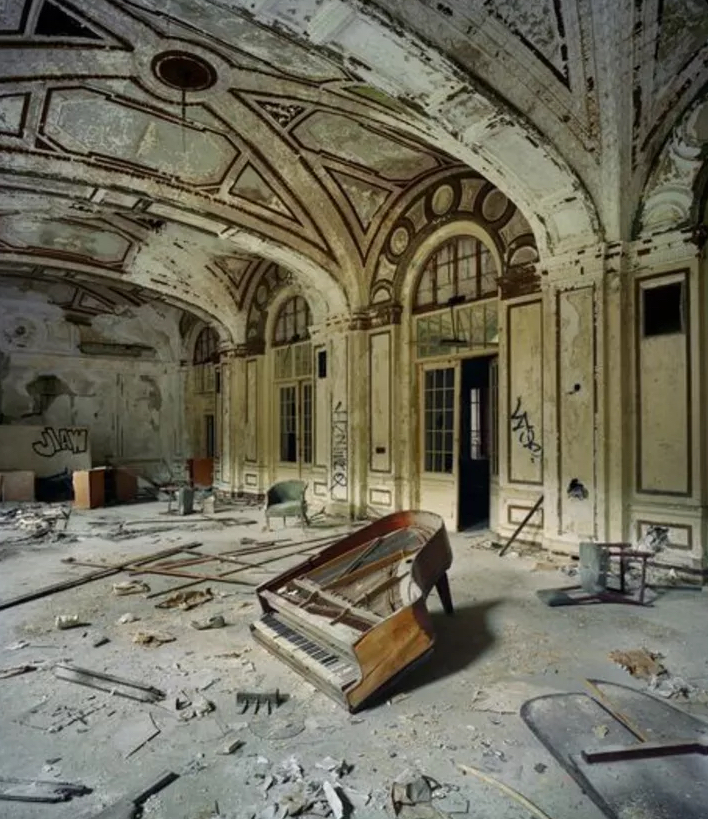
Andrew Moore’s photograph Piano Lee Plaza, 2008 is a hauntingly beautiful composition that captures the intersection of decay, history, and the resilience of art. Taken in the Lee Plaza Hotel in Detroit, Michigan, the image depicts a grand piano abandoned in a crumbling ballroom. The photo evokes powerful emotions, blending the melancholy of urban decay with the majesty of an instrument that once echoed melodies through the grand halls of this iconic building.
This image is more than just a photograph; it is a story. It speaks to the rise and fall of Detroit, the fragility of human ambition, and the unexpected beauty found in abandonment. Let us explore the layers of meaning in Piano Lee Plaza, 2008—examining its historical context, artistic elements, and the broader themes it represents.
The Historical Context of Lee Plaza
Lee Plaza Hotel was once a beacon of Detroit’s opulence. Built in 1929, it stood as an emblem of the city’s booming economy during the height of the industrial age. The 15-story Art Deco building featured luxurious apartments and hotel rooms, adorned with intricate moldings, marble finishes, and elegant ballrooms. It was a symbol of prosperity, attracting the city’s elite.
However, the prosperity of Detroit was not to last. The decline of the American auto industry in the mid-20th century led to economic hardship, population loss, and widespread urban decay. By the 1990s, Lee Plaza had fallen into disrepair, a victim of neglect and vandalism. By the time Andrew Moore captured his image in 2008, the building was an empty shell, stripped of much of its former grandeur.
A Piano in Decay: The Subject of the Photograph
At the heart of Piano Lee Plaza, 2008 lies a grand piano, its frame and keys ravaged by time and the elements. The instrument is battered, its once-polished wood chipped and faded. Yet, even in its ruined state, it retains a quiet dignity, standing resilient amid the chaos of the room.
The juxtaposition of the piano’s refined craftsmanship against the peeling paint and debris of the ballroom creates a poignant contrast. The piano, an object designed to produce harmony and beauty, is now a silent witness to the building’s decline. Its presence suggests a narrative: Who played this piano? What music once filled this room? The questions linger, adding a layer of mystery to the scene.
The Composition: Light, Background, and Space
Moore’s mastery of composition is evident in this photograph. The natural light streaming through the broken windows creates an ethereal glow, illuminating the piano and casting dramatic backdrops across the room.
The photograph’s framing draws the viewer’s eye to the piano, which sits slightly off-center. Surrounding it are elements of the room in various states of disrepair, creating a sense of depth and spatial complexity. Moore’s use of color is subtle but impactful; the muted tones of the room contrast with the dark silhouette of the piano, making it the focal point of the image.
Themes Explored in the Photograph
The Passage of Time
Piano Lee Plaza, 2008 is a meditation on time. The once-vibrant Lee Plaza and its grand piano are now relics, marked by the inevitable march of time. The decay is not hidden; instead, it is celebrated, revealing the beauty of imperfection and the natural processes of aging and entropy.
Resilience and Fragility
The photograph captures the tension between resilience and fragility. The piano, though damaged, remains standing—a testament to its construction and purpose. Similarly, the building itself, despite its state of disrepair, retains echoes of its former grandeur. This resilience contrasts with the fragility of human ambition, as symbolized by Detroit’s decline.
The Role of Art in Human Experience
The image prompts reflection on the role of art and music in human life. The piano, an instrument of creativity, represents the cultural aspirations of a bygone era. Its abandonment in this setting suggests a loss—not just of a building, but of the dreams and artistic expressions that once thrived within it.
Andrew Moore’s Vision
Andrew Moore is renowned for his ability to capture the intersection of architecture, history, and humanity. His photographs, often centered on decaying buildings, are not merely documentary but deeply evocative. Moore does not shy away from the gritty details of decline; instead, he finds beauty in them, challenging viewers to see decay as part of a broader narrative.
In Piano Lee Plaza, 2008, Moore’s vision is particularly powerful. The photograph is not just about a piano or a building; it is about a moment in time, frozen yet filled with movement. The crumbling walls and the abandoned piano tell a story of loss, but they also suggest hope—the potential for rebirth and renewal.
Broader Implications: Detroit and Urban Decay
Detroit, often referred to as the “Motor City,” has become a symbol of urban decay in America. The decline of the auto industry and subsequent economic challenges led to the abandonment of many buildings, including Lee Plaza. However, Detroit’s story is not just one of decline—it is also one of resilience and reinvention.
In recent years, there has been a growing interest in preserving and repurposing Detroit’s historic buildings. The Lee Plaza Hotel itself is slated for redevelopment, a project that aims to restore its former glory while adapting it for modern use. Moore’s photograph captures a pivotal moment in this narrative, documenting the building in its raw, unaltered state before its potential rebirth.
The Emotional Resonance of Decay
Why do images like Piano Lee Plaza, 2008 resonate so deeply with viewers? Part of the answer lies in our fascination with decay. There is something profoundly moving about seeing beauty in ruin, about finding meaning in the remnants of the past. Moore’s photograph invites us to reflect on impermanence, memory, and the layers of history that shape our world.
The piano, in its silent solitude, becomes a metaphor for lost dreams and forgotten stories. Yet, it also serves as a reminder of the enduring power of art and the human spirit. Even in decay, there is a quiet dignity that speaks to the resilience of creativity.
Piano Lee Plaza, 2008 by Andrew Moore is more than a photograph; it is a visual poem, rich with layers of meaning. Through his lens, Moore captures the soul of a building, an instrument, and a city—inviting viewers to see beauty where others might see only destruction.
This image reminds us that art has the power to preserve history, to tell stories that might otherwise be forgotten. It challenges us to look beyond the surface, to find meaning in the details, and to embrace the complexity of time and change.
As Lee Plaza moves toward a new chapter in its history, Moore’s photograph stands as a testament to its past—a poignant reminder of what was, and a hopeful nod to what could be. The grand piano may never play again, but its presence, immortalized in this image, continues to resonate.
No comments yet.








